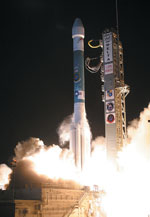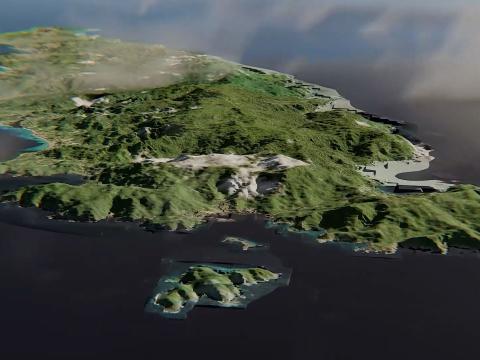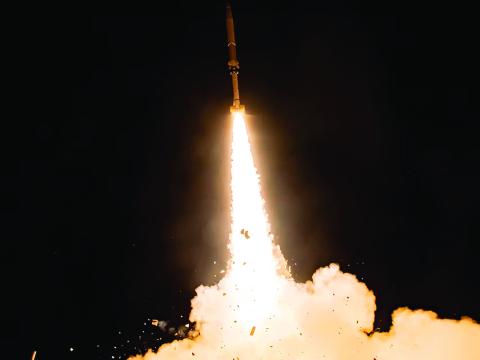Space Now a Contested Venue
 |
A U.S. Air Force sensor management analyst at the Joint Space Operations Center, Vandenberg Air Force Base, California, verifies the accuracy of a tracking station’s observations of several artificial objects orbiting the Earth. Tracking orbital objects and determining their purpose has become more vital as a growing number of nations challenge U.S. capabilities in space. |
The proliferation of international space systems and an increase in the number of technologies that can physically threaten satellites has led the U.S. Defense Department to redefine space as a contested environment. The chairman of the Joint Chiefs of Staff has issued a special area of emphasis, or SAE, applying this designation to space for the military community. The result will be a change in the way military personnel view space and incorporate its role in their training regimens.
The January 2007 test of a launch-to-orbit antisatellite system by the People’s Republic of
Other means can be employed against space-based capabilities. Deliberate radio frequency interference, electromagnetic pulses and directed energy weapons such as antisatellite (ASAT) lasers all have been tested in one form or another. Down to Earth, a team of commandos can disrupt satellite operations by attacking and disabling a key ground station.
In addition to direct action by an enemy, the
Col. Sean D. McClung, USAF, is the director of the National Space Studies Center (NSSC) in the U.S. Air Force Air University at Maxwell Air Force Base,
“The
“Space historically has been thought of as a sanctuary,” the colonel continues. “But, sanctuaries by definition are not crowded places; and space has become very crowded in recent years as more and more countries develop space capabilities and the ability to operate in, around and through space.”
The 2001 Commission to Assess United States National Security Space Management and Organization—also known as the Space Commission—outlined some deficiencies in the way the United States was handling its space assets and developing a space culture within the military, Col. McClung relates. Following the September 11, 2001, terrorist attacks,
“Space capabilities really underpin our American way of life,” he observes. “It’s no longer just the [military] high ground; it is essential to commercial aspects of our nation and to scientific discovery.” He continues that the nation’s military has an obligation to protect critical national capabilities, one of which entails space-based assets.
“Nearly 100 percent of the product that comes from space is information,” Col. McClung declares. “Space and cyber are integrally connected with each other.”
Currently, many vital commercial activities depend on space-based assets. The Global Positioning System (GPS) has been integrated into daily operations in all manner of businesses, while communications satellites provide vital linkage for financial transactions down to credit card uses. As the
With this in mind—and at the request of a
“We discovered we had less of space as a topic area in our joint professional military education curriculum than we did in the mid-1980s, even though our dependencies had grown substantially,” the colonel relates. “That really gave us cause for concern.”
Mark Stout, deputy director for strategic programs at the NSSC, describes two watershed events that led to the development of the SAE. One was the 2007 Chinese ASAT test. The other was a group research project at the
The NSSC’s aim for its work that helped generate the SAE is to provide a framework for the joint professional military education community, particularly joint service schools at the intermediate and senior levels, Col. McClung states.
 |
A Delta II rocket lifts off from Cape Canaveral Air Force Station in Florida carrying a new Global Positioning System (GPS) satellite. GPS is incorporated in everyday government, military and public activities, and the vulnerability of its satellites and signals makes it a tempting target for an adversary seeking to wreak havoc on the United States. |
As much as space-based assets have increased in number and importance, those metrics are likely to grow in the foreseeable future. Bandwidth demands for
“Space is a critical enabler for everything that is done on the battlefield, and the services have presupposed much of their modernization and transformation on the availability of space,” Stout says.
He notes that war game planners have related how a catastrophic event that removes space-based capabilities never is incorporated into a war game. This inclusion has not been authorized because any war game in which that event takes place grinds to a halt immediately. Without space capabilities, the war game’s activities end. “The obvious lesson in the real world is that, while the world would continue to revolve on its axis, we would lose a tremendous amount of capability if we were to lose space,” Stout concludes.
“We have transformed into smaller, more technologically capable and more technologically dependent forces,” Col. McClung states. “We’re no longer trained to operate without space; we no longer are manned to operate without space. If you take space out of the equation, you roll back the clock decades in our warfighting capabilities—and you create the scenario that we would have to reconstitute our force to be much larger and more manpower intensive and much less technologically advanced than the force we have now. [That would be] a force that has incredible budget implications and would be much more expensive to field.
“I don’t believe that any of the services want to turn that clock back,” he continues. “The question is, how do we move forward and be able to protect this environment and protect our technological edge against whatever enemies might appear?”
Having been issued by the chairman of the Joint Chiefs of Staff, this SAE applies strongly to joint professional military education. However, it will take more than one year of emphasis to produce results, Col. McClung says. This SAE must be incorporated fully in service schools to be effective, he adds.
Stout adds that much remains to be done for this effort to be an effective multiyear process. “It’s not an inoculation that you can give one time to make everybody space-smart after that,” he says. “It is a level of effort that will require some endurance.” The NSSC has worked with the National Security Space Institute to develop curriculum content as the SAE moves forward. And, this fall, the Air Force Research Institute at the
The new Obama administration’s goal of banning weapons that interfere with military and communications satellites is not yet official government policy, but it does indicate the general direction that might be taken by administration policy, Col. McClung notes. It will affect how the military addresses the issue of contested space, and the military may have to revisit the issue of deterrence in a contested environment, he says. Deterring hostile actions against space systems has not yet been determined, as planners must ascertain just how to ensure concrete consequences for these hostile actions—and when to respond.
Stout observes that no common definition exists for a space weapon. Anything or anyone that destroys a satellite ground station theoretically could be classified as a space weapon. This is just one of the definitions that must be established for building policy, and these policy implications should be considered before any action needs to be taken, he adds.
“Our enemies don’t need any convincing that our military is enabled incredibly by space systems,” Col. McClung says. “Whether those space capabilities are riding on a commercial satellite or on a dedicated military satellite, I’m not sure our enemies will make that distinction. They will look at it as, ‘anything that provides a military capability may be a legitimate military target.’”
Supporting space systems may take several forms. Stout offers that having a robust satellite constellation that is not degraded easily is one way of ensuring space viability. Another way is possessing the ability to restore a space capability “in an accelerated period of time.” Both the Defense Department and the Air Force are moving away from complete reliance on exquisite systems toward some systems that are “good enough” to give a warfighter the required capability.
Viewing space as “contested” does not necessarily translate to “hostile,” Col. McClung emphasizes. The colonel emphasizes that the proliferation of other nations’ space assets does introduce some good elements. Collaboration and cooperative ventures lead other nations to become dependent on the space environment, which in turn reduces the motivation to attack other nations’ space systems. Even a successful space attack that leaves the attacking nation’s assets intact may backfire through the spread of orbital debris that can destroy that country’s satellites days or even years later.
But nations are moving into space for their own needs. Among other spacefaring countries,
The increased presence in space does not end with
Col. McClung points out that many space capabilities are dual-use. “Capabilities that can be used for peaceful purposes also can be used as a demonstration of potential military capability,” he says, citing as an example
“These kinds of things … underscore our need to know what is in space and what its purposes are,” he points out. “That really speaks to the whole issue of having a better space situational awareness capability—to know in fact what is on orbit, why it’s there, what its purposes are and to have a method of verifying those capabilities.”




Comments